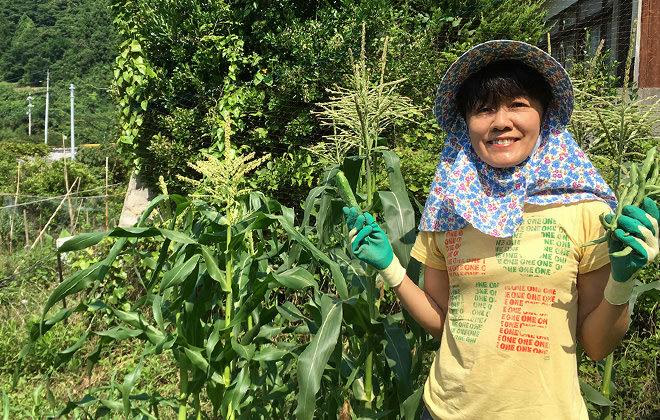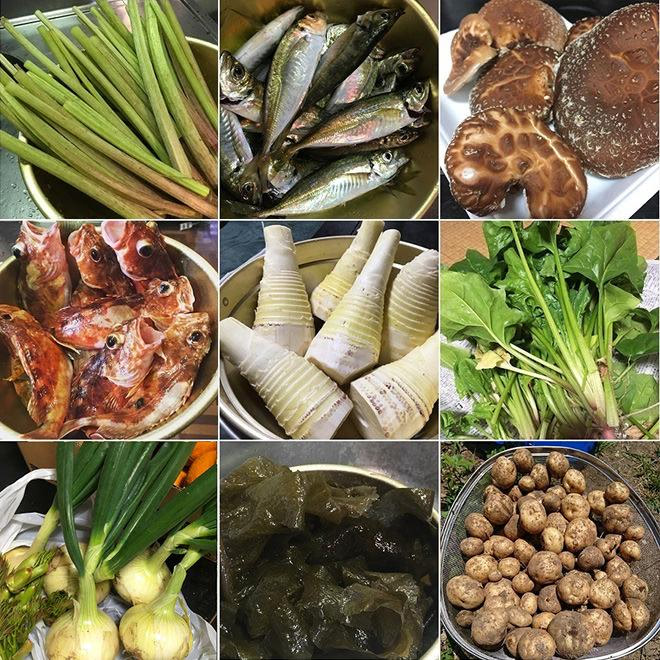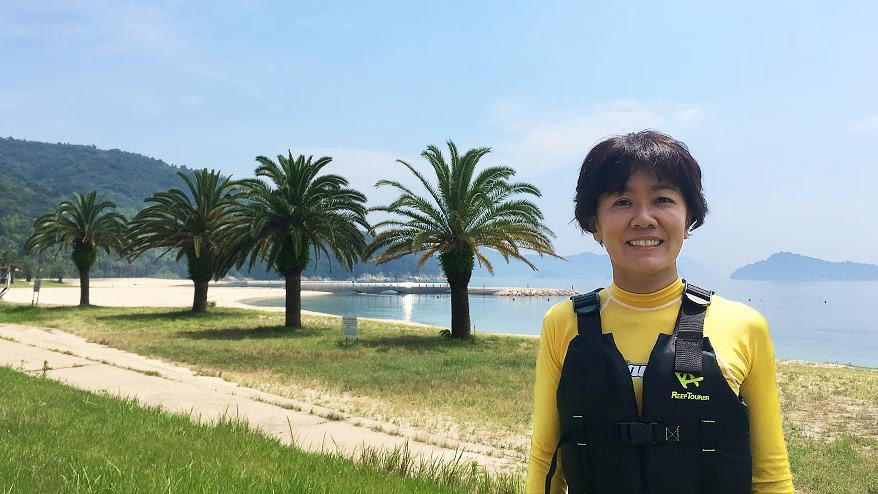周防大島での暮らしも、はや5か月目に差し掛かった永井です。
3月に引っ越してきた当初は、あまりの寒さに「温暖な瀬戸内」というイメージに騙された!と、すでに冬服を片付けたことを後悔したのも懐かしい思い出。7月に入ってからは、家から徒歩2分のプライベートビーチ(真っ昼間はほとんど誰もいないので、勝手にそう呼んでいます)での海水浴に興じる夏がやってまいりました。暑い日には、1時間ほど時間ができると、さくっと30分ほど海で泳いで、30分でシャワーと身支度、午後の仕事に戻るなんてこともできちゃいます(東京の皆さまスミマセン)。
そんな周防大島から、今月は暮らしのことを中心に、東京での暮らしとの違い、そのなかで気づいたことなどをお伝えします。
日々の過ごし方(東京 vs 周防大島)
「東京と違って、何もなくて暇でしょう?」
「ここは、交通も買い物も不便でしょう?」
周防大島での暮らしを始めた時、ご近所さんや、近くに住んでいる親類の方々によくそんな声をかけられました。けれど、私自身、実はそんな変化にピンと来ていませんでした。
元々、東京に住んでいたときでも、休みの日は、ジムのプールに行くか、テレビを見るか、たまにがんばって箱根や静岡の温泉に行く...というのが私の過ごし方でした。
周防大島にずっと住んでいる方々にとって、東京に住む人は、毎週のように渋谷や新宿などの繁華街に買い物に行ったり、映画を見たり、話題のカフェやイベントに行ったりしているイメージなんでしょうか...?

周防大島の家庭菜園。今日の収穫はきゅうりといんげん。とうもろこしももうすぐです。
周防大島に来てからは、ジムでの運動の替わりに草刈りをしたり(けっこう体力使います!)、テレビの代わりに家庭菜園の野菜の育ち具合を見に行ったり(毎日変化があって飽きません)、温泉は、片道1,2時間もかけなくても20分で到着です。...ほら、あまり変わっていないでしょう?!
お金の使い方(東京 vs 周防大島)
ところが、お金の使い方については、意外に違いがありました。人それぞれ、家庭それぞれ、いろいろでしょうが、私のケースを紹介してみたいと思います。
夫婦2人暮らし、2人とも大の食いしん坊で吞んだくれ。逆に着るものはユニクロか無印良品(丈夫で長持ちするシンプル服)で満足していて、あまり買わないという家庭のサンプルです。
1か月の生活必要経費
| 東京(神奈川県厚木市)の暮らし | 周防大島の暮らし | 増減 | |
| 家賃 | 15万円 | 5千円!(相場は2万円~5万円) | −14万円 |
| 食費(酒類含む) | 10万円~∞(!) | 4万円 | −6万円以上 |
| 家事代行 | 3万円 | 0円 | −3万円 |
| ジム | 2万円 | 0円 | −2万円 |
| 水道光熱費 | 1万5千円~2万円 | 2万円 | ほぼ ±0円 |
| ガソリン代(通勤以外) | 0~1万円 | 2~3万円 | +2万円 |
| 自治会費・ご近所付き合い | ほぼ 0円 | 2千円~1万円 | +1万円 |
| 合計 | 約33万円 | 約11万円 | −約22万円 |
家賃と食費での約20万円の差は大きいです。
家賃は地価が違うので当然として、それ以外では私の家庭の場合、食費の違いが大きく出ました。
夫婦フルタイムで働いていたこともあり、東京では、昼・夜はほぼ外食、そのうえ2人とも大の食べるの好き、お酒好きときていますから、食費がとても大きかったことを実感です。この食については後ほど詳しくお伝えします。
また、金額の比率はそれほどでもないものの、毎月3万円の家事代行(週1~2回、家の掃除や洗濯をしてくれる)がなくなったことで、生活が変わりました。今までお金でサービスを買っていた家の掃除や2人分の洗濯・ゴミ出しなどは、すべて自分たちの仕事になりました。
余談ですが、夫婦どちらかまたは両方が家事大好きというわけではなく、仕事を頑張りたい共働きのご家庭でしたら、家事代行サービスは相当おススメです。ちょっともったいないなと思っても、家がきれいで、家族がニコニコできる時間を3万円で買える幸せを、ぜひ多くの人に実感していただきたいものです。(周防大島にきて家事代行サービスが受けられなくなって残念でなりません!)
逆に、周防大島に来てから増えた費用もあります。
まずはガソリン代。スーパーも最寄り駅も往復1時間以上かかり、その上燃費の悪い山道を走るので、ガソリンの減りは予想以上です。また、地域の祭りやイベントが1,2か月に1度はあるので、その都度寄付や会合のお食事など、今までかからなかった想定外の出費もありました。

ちょっと県道を外れるとこんな道も。草をかき分け、ツルをよけつつ、斜度も30度はありそう⁈燃費も悪くなるはずです。
水道光熱費は、トータルでは増減なしですが、エアコンをつける回数が減って電気代が減っている割に、追加で必要になった汲み取り費用(ここには下水道がありません)が高かった!まあこれは、人力なので頭が下がる作業。仕方ないですね。
住み始める前に、周防大島の定住促進の担当者の方から、「田舎に来るとお金がかからない、はウソです!そんな甘い考えでは生活できないですよ」と釘を刺されたことがありました。自給自足でお金がほとんどかからないような生活を夢見て(そんな人が意外に多いそうです)、実際に来てこんなはずじゃなかった...とならないようにというアドバイスなのでしょうが、それでも都市部に比べると安い費用で充分な生活ができるように思います。
一番変わった「食生活」
お金がかからない一方で、生活の「知恵」と「時間」が必要になることは増えました。私の場合、何といっても一番変わったのは食生活でした。
周防大島に来るまで、私のなかでは「外食ができなくなること」が最大の懸念でした。毎日のように外食だったので、自炊するのがストレスになるんじゃないかという不安。プロの味を再現しづらい揚げ物やカタマリの肉料理、外食ならではのピザやホルモン焼き...食事のバリエーションが少なくなることは、食いしん坊の私にとって大きな心配事でした。
けれど、実際に引っ越してから5か月、今のところ、意外にストレスを感じません。
その理由は、食材です。こちらの食材は旬のものが新鮮!新鮮というだけでおいしい!だから野菜はゆでただけ、魚は焼いただけのシンプル料理でも、充分おいしいのです。

周防大島の食材たちの一例。左上から、ふき、鯵、シイタケ、カサゴ、たけのこ、ほうれん草、葉つき玉ねぎとタラの芽、わかめ(生)、じゃがいも。海の幸・山の幸を採ってきたり、いただいたりだから、お金はゼロ円!ただし、家にやってきてから食卓に上るまで、どれも都会のスーパーで買うよりひと手間余計にかかります。
もちろん、地元でもスーパーやコンビニエンスストアは、都市部とさほど変わらない品揃えなので、買う物には困りません。手抜きしたいときは、カップラーメンや冷凍ギョウザで終わる日もあります。
「今日はレトルトカレーで済まそうか」
しかし、そんな気持ちになっている日に限って・・・いただけるのです、採れたて食材を。
食いしん坊の私としては、これらのブツを前に、そのままに放ってはおけません。
ただし、それらは「畑での姿のまま」「海での姿のまま」の状態で我が家にやってきます。ゆでる前のドス黒いわかめを見たのも初めてだったし、生のタコ(写真映えしないので掲載しません)の気持ち悪いヌルヌル感も、実際に体験したことはありませんでした。
「姿のまま」の食材を調理するのは、ある意味、不便で労力がかかります。外食ではお金を払ったら、はい、どうぞとすぐに食べられる状態でしたが、野菜は土を洗うところから、たけのこはあく抜きだけで1時間も下茹でが必要です。海で泳いでいた姿のままの魚は、当たり前ですが1匹1匹ハラワタやうろこをとる必要があります。
このように、使うお金が減ったことと引き換えに、生活の知恵や時間が必要になりました。Google先生には、フキのゆで方や魚の3枚おろしなど、日々いろいろなことを教えていただき、感謝でございます!
豊かな暮らし=不便な暮らし?
今ではこんな生活をしている私ですが、実は、都市に生活している間、田舎での生活を「豊かな暮らし」「丁寧な暮らし」などと表現してもてはやしているメディアや人の話には、違和感を覚えていました。
それって、不便ということを美化して伝えているだけじゃないの?
お金をたくさん稼いでサービスを享受したいのをあきらめる言い訳じゃないの?
どの辺がそんなにうらやましく憧れることなの? と。
しかし、ここ周防大島に来て、生活の一部分を、お金ではなく自分やまわりの人の知恵と労力で解決することの価値について、少しわかってきたことがあります。
でもまだ、ことばにすると陳腐で、私が違和感を覚えていたあれらのフレーズと同じになってしまいそうなので、今回はここまでにします。そして、いつかちゃんと自分で納得する言葉にできる日に、あらためて伝えたいと思います。
